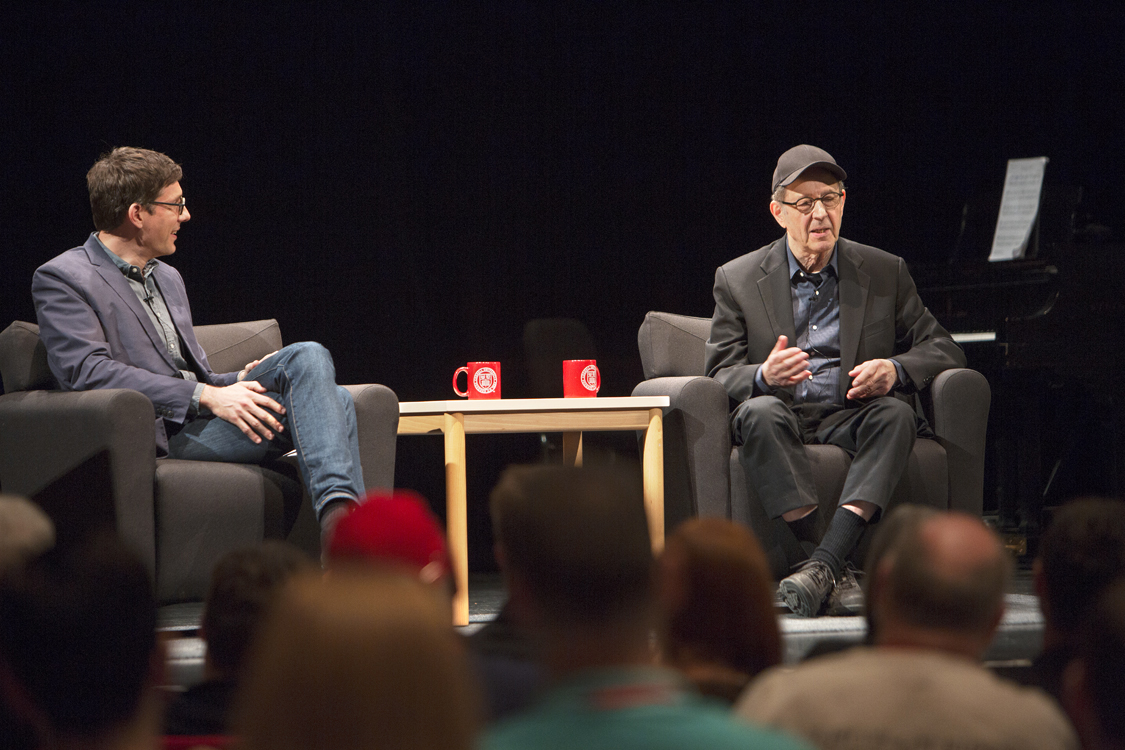Minimalist composer Steve Reich regales alumni at Reunion
By Susan Kelley

Despite having won a Pulitzer Prize and Grammy awards for his music, composing doesn’t come easy to Steve Reich ’57.
“Every piece is really depressing and terrifying to begin, because I don’t know what I’m doing, and I go around [saying], ‘It’s time for a donut’ or anything else,” Reich said at the Olin Lecture June 9 in Bailey Hall.
The lecture, a highlight of Reunion Weekend, opened an illuminating window into the mind of a Cornellian whom The New York Times has called “among the great composers of the century.”
President Martha E. Pollack introduced Reich, noting the 2016-17 season marks his 80th birthday with more than 400 performances in 20 countries celebrating his music and his legacy. A music minor and philosophy major at Cornell, Reich writes music known for steady pulse, repetition and a fascination with canons, also known as rounds. He’s also known for writing rigorous structures with propulsive rhythms.
The lecture opened with two Reich pieces – “Nagoya Marimbas” and “Quartet” – performed by Ensemble Signal.
Then a spry Reich walked onstage with Benjamin Piekut, associate professor of musicology, for a 40-minute conversation about Reich’s work.
At Cornell, Reich took a number of classes with William Austin, professor of music, who took a radical approach to teaching music history. Austin began with Gregorian chant – a traditional starting point – and worked his way through the death of J.S. Bach, Reich remembers. But then he jumped ahead 150 years, to Stravinsky, Schoenberg and Ellington.
“I loved that part of the class,” Reich said. “Bill Austin made me aware that my personal emotional magnetism was drawn to music from 1750 and back, and from Stravinsky forward, and less so in the middle.
“Now, in the middle are great geniuses. … But it doesn’t mean you are obliged to spend your life focusing on that. You’re obliged to spend your life focusing on that which will be most fruitful for you and, therefore, for other people.”
He heard that influential music on recordings, and recordings have played an important role in his musical life, he said. His earliest work frequently used tape, looped and played back at different speeds. He has heard about half the music in his lifetime live, and half on recordings, he said. “What does that do to you as a listener? It gets you used to listening to a lot of detail,” he said. “The microphone creates a balance, which is not a crutch. It’s part of the orchestration.”
Along with recordings, in his early work, Reich was influenced by Balinese gamelan and African drumming, neither of which have harmony in the Western sense. “They are creating musical interest through rhythmic complexity and melodic complexity as a result of the interlocking patterns that are created in those musics,” he said.
He took elongated tones from Pérotin, a composer from 11th-century Paris, he said. And he learned from saxophonist John Coltrane, who kept the listener’s interest even while playing just a handful of chords for extended periods of time. “He had timbre variety, melodic invention, rhythmic complexity, and you can listen to [the key of] E for 17 minutes and love it,” Reich said.
Coltrane, who led and played with a quartet, inspired Reich to do the same. “Now I’m no John Coltrane,” he said. “But with all my limitations, I felt, I’ve got to play my pieces, and whatever my limitations are, that will be the limitations of the music.”
He formed his ensemble, Steve Reich and Musicians, in the mid-1960s, which marked a new stage of his career focused on composing and performing.
But his interest in rhythmic patterns continued. In “Drumming,” he said, a piece composed for a nine-piece percussion ensemble with female voices and piccolo, “We’re playing in unison and I pull away slowly, as slowly as I can, until I get one 16th note ahead. And we hold. And what you hear are basically canons, or rounds, like ‘Row, Row, Row Your Boat,’ except instead of a tune you’re hearing a pattern.”
Different people, depending on where they’re sitting, will hear different patterns, he said. “It’s like looking at a complex rug, and saying, ‘Hey, do you see that pattern over there?’”
Reich began writing complex pieces in 1981 and eventually wrote himself out as a performer. Now, when he travels he sits in with ensembles or coaches, or both – although arthritis in both thumbs makes it harder to sit in, he said.
“Time passes,” he said. “The good news is there are so many great musicians out there who really know how to do it without a word being said.”
Michael Slon ’92, a conductor and music professor at the University of Virginia, came to the lecture to hear in person a leading composer.
“As a music professor but also always being a student of music,” Slon said, “I think it gives you a chance to create a richer portrait, a richer understanding, of the trajectory of music in the 20th and 21st century.”
Media Contact
Get Cornell news delivered right to your inbox.
Subscribe